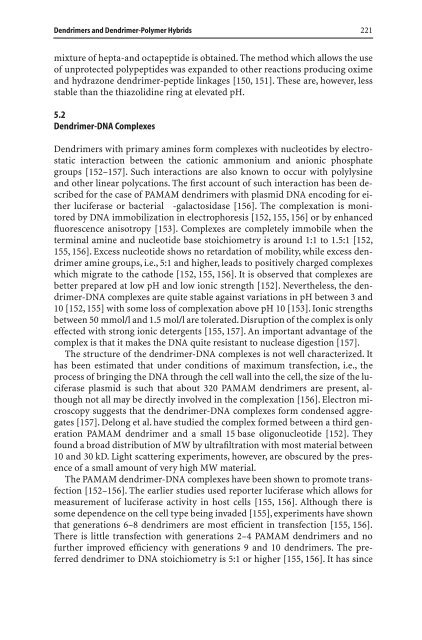142 Advances in Polymer Science Editorial Board: A. Abe. A.-C ...
142 Advances in Polymer Science Editorial Board: A. Abe. A.-C ...
142 Advances in Polymer Science Editorial Board: A. Abe. A.-C ...
Create successful ePaper yourself
Turn your PDF publications into a flip-book with our unique Google optimized e-Paper software.
Dendrimers and Dendrimer-<strong>Polymer</strong> Hybrids 221<br />
mixture of hepta-and octapeptide is obta<strong>in</strong>ed. The method which allows the use<br />
of unprotected polypeptides was expanded to other reactions produc<strong>in</strong>g oxime<br />
and hydrazone dendrimer-peptide l<strong>in</strong>kages [150, 151]. These are, however, less<br />
stable than the thiazolid<strong>in</strong>e r<strong>in</strong>g at elevated pH.<br />
5.2<br />
Dendrimer-DNA Complexes<br />
Dendrimers with primary am<strong>in</strong>es form complexes with nucleotides by electrostatic<br />
<strong>in</strong>teraction between the cationic ammonium and anionic phosphate<br />
groups [152–157]. Such <strong>in</strong>teractions are also known to occur with polylys<strong>in</strong>e<br />
and other l<strong>in</strong>ear polycations. The first account of such <strong>in</strong>teraction has been described<br />
for the case of PAMAM dendrimers with plasmid DNA encod<strong>in</strong>g for either<br />
luciferase or bacterial b-galactosidase [156]. The complexation is monitored<br />
by DNA immobilization <strong>in</strong> electrophoresis [152, 155, 156] or by enhanced<br />
fluorescence anisotropy [153]. Complexes are completely immobile when the<br />
term<strong>in</strong>al am<strong>in</strong>e and nucleotide base stoichiometry is around 1:1 to 1.5:1 [152,<br />
155, 156]. Excess nucleotide shows no retardation of mobility, while excess dendrimer<br />
am<strong>in</strong>e groups, i.e., 5:1 and higher, leads to positively charged complexes<br />
which migrate to the cathode [152, 155, 156]. It is observed that complexes are<br />
better prepared at low pH and low ionic strength [152]. Nevertheless, the dendrimer-DNA<br />
complexes are quite stable aga<strong>in</strong>st variations <strong>in</strong> pH between 3 and<br />
10 [152, 155] with some loss of complexation above pH 10 [153]. Ionic strengths<br />
between 50 mmol/l and 1.5 mol/l are tolerated. Disruption of the complex is only<br />
effected with strong ionic detergents [155, 157]. An important advantage of the<br />
complex is that it makes the DNA quite resistant to nuclease digestion [157].<br />
The structure of the dendrimer-DNA complexes is not well characterized. It<br />
has been estimated that under conditions of maximum transfection, i.e., the<br />
process of br<strong>in</strong>g<strong>in</strong>g the DNA through the cell wall <strong>in</strong>to the cell, the size of the luciferase<br />
plasmid is such that about 320 PAMAM dendrimers are present, although<br />
not all may be directly <strong>in</strong>volved <strong>in</strong> the complexation [156]. Electron microscopy<br />
suggests that the dendrimer-DNA complexes form condensed aggregates<br />
[157]. Delong et al. have studied the complex formed between a third generation<br />
PAMAM dendrimer and a small 15 base oligonucleotide [152]. They<br />
found a broad distribution of MW by ultrafiltration with most material between<br />
10 and 30 kD. Light scatter<strong>in</strong>g experiments, however, are obscured by the presence<br />
of a small amount of very high MW material.<br />
The PAMAM dendrimer-DNA complexes have been shown to promote transfection<br />
[152–156]. The earlier studies used reporter luciferase which allows for<br />
measurement of luciferase activity <strong>in</strong> host cells [155, 156]. Although there is<br />
some dependence on the cell type be<strong>in</strong>g <strong>in</strong>vaded [155], experiments have shown<br />
that generations 6–8 dendrimers are most efficient <strong>in</strong> transfection [155, 156].<br />
There is little transfection with generations 2–4 PAMAM dendrimers and no<br />
further improved efficiency with generations 9 and 10 dendrimers. The preferred<br />
dendrimer to DNA stoichiometry is 5:1 or higher [155, 156]. It has s<strong>in</strong>ce
















